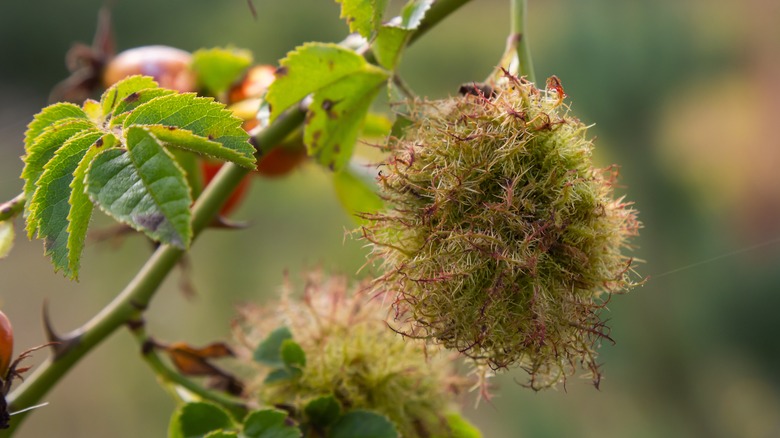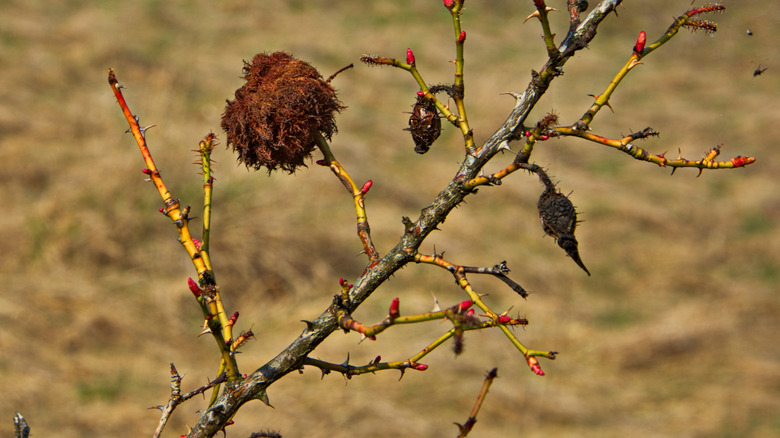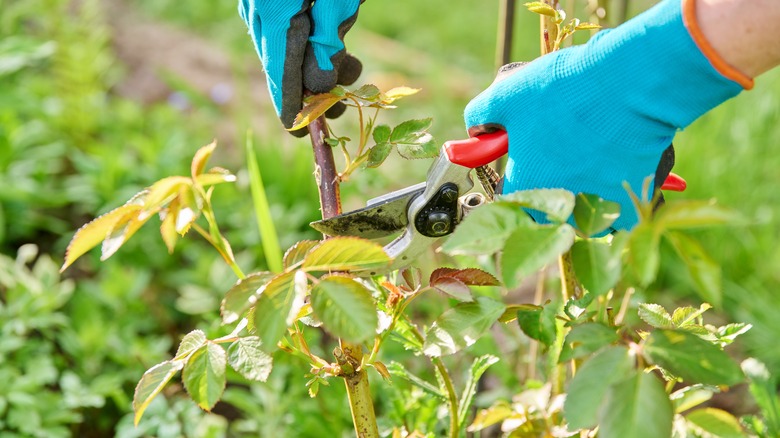What Is Mossy Rose Gall, And Is It Harmful To Your Plants?
If you grow roses, whether you plant varieties that will make your garden smell heavenly or traditional shrubs for their beautiful blooms, you've probably found that they're temperamental, to put it kindly. Not only do many rose varieties require specialist care, but they're also susceptible to all manner of diseases, pests, and abnormal growths — including mossy rose gall. Also known as rose bedeguar gall and Robin's pin cushion, this is a sizeable fuzzy growth created through a biological relationship between your rose and a tiny parasitic wasp and its grub-like offspring. Whether the galls are harmful to your rose bushes is debated even by experts. It depends on how many galls a plant has, but typically, they don't drastically harm the health of the plant.
The wasp responsible for creating mossy rose galls is Diplolepis rosae, just one of the 750-plus species of cynipid or gall wasps in North America. Because the asexual adult wasps are extremely small, just ⅛ to ¼ inches long, you likely won't see them. However, if you cut a gall open, you'll spot their wormy larvae, which feed on the plant tissue inside. Galls are created when a wasp lays eggs on a rose leaf bud. The eggs then hatch into larvae that secrete chemicals which reprogram the bud to grow into an initially hairy red or green growth that later develops into a brown and woody gall.
Galls are typically harmless
Most experts agree that mossy rose galls rarely harm host plants despite the larvae drawing nutrients from the leaf or stem the gall is situated on. Additionally, a wasp creates just one generation annually (albeit a relatively substantial generation, with adults laying up to 60 eggs each), so they won't multiply quickly and overtake a plant. Plus, the wasps are a known food source for bigger critters like birds.
However, some people consider galls distasteful since they distort the plant's growth and overshadow the pretty blooms. Furthermore, a plant with lots of galls may become stressed and even die as the growth draws nutrients away from vital functions. Infected branches can wither and fall above the site of the gall as well, but these negative effects rarely happen.
Because they're typically harmless, instead of trying to combat mossy rose gall with chemical insecticides to get rid of the wasps, it's usually best to leave them alone. As we note above, most garden gurus agree that roses survive just fine with a few galls. What's more, pesticides are rarely effective. This is because it isn't easy to time the application correctly. To be effective, you need to kill the wasps as they emerge from the gall in the spring before they can lay new eggs in budding leaves. Applying pesticides to the gall itself at any time of year is pretty much useless, as the chemicals can't reach the larvae nestled inside their protective nest.
What to do about mossy rose galls
If your roses are plagued by galls and you want to test a chemical insecticide, experts suggest spraying emerging buds with a carbamate or pyrethroid insecticide. Pruning, however, is the most effective way to rid your plants of mossy rose galls. The idea is that removing galls from the plants will limit the chance of new eggs being laid in the following seasons. Some experts say to do this in the spring and others after the fall leaf drop. Either way, you need to prune galls before larvae transform into adult wasps. Make an angled cut below the gall at a five-leaf junction and burn or throw away clippings; don't compost the galls. Also follow the best tips on how to prune your roses as you typically would.
Other general gall wasp control measures include regularly raking and disposing of fallen leaves (again, not composting them) and keeping your plants as healthy as possible. Evidence suggests that galls appear more often on stressed and heavily-pruned roses. Avoid planting Rosa acicularis, Rosa arvensis, Rosa canina, Rosa rugosa, Rosa woodsii var. woodsii, Rosa multiflora, and some hybrid tea (old-world) roses, which are all favored gall wasp hosts. Cultivate modern varieties and hybrids instead. You can also leave it up to nature. Unfavorable weather conditions and predators keep wasp populations in check in most cases. Alternatively, lean into your inner nature documentarian and watch them develop over the seasons, as the galls are pretty fascinating.


